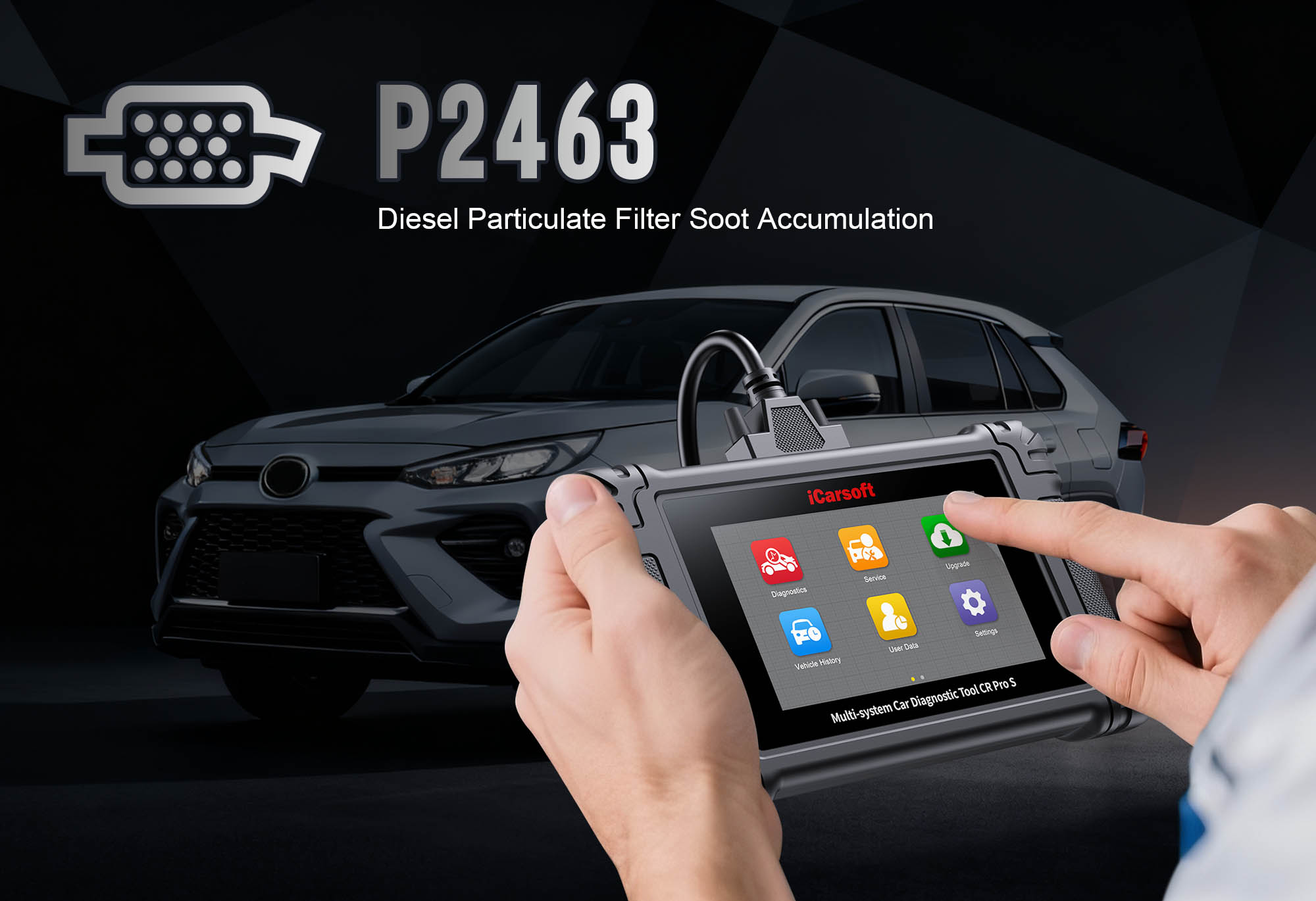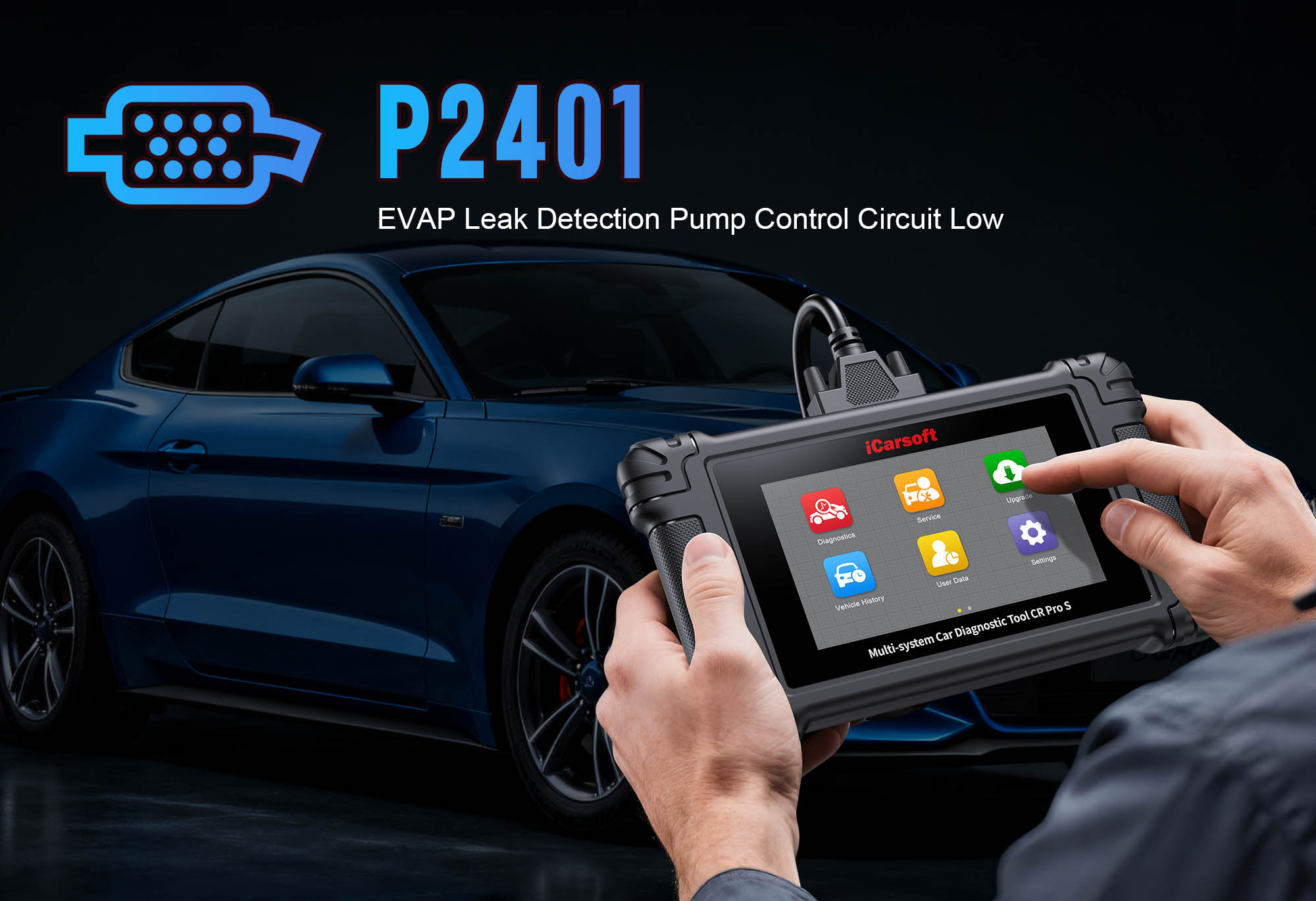Diagnose & Clear P2635 with iCarsoft CR MAX BT
If your vehicle’s check engine light illuminates, you experience rough idling, or it struggles with acceleration (especially under load), a diagnostic scan will likely return P2635. This OBD-II code stands for "Fuel Pressure Regulator Control Circuit Range/Performance"—a fault targeting the electronic fuel pressure regulator (FRP or FPR) and its control circuit. The Engine Control Module (ECM) relies on the fuel pressure regulator to maintain precise fuel rail pressure (e.g., 40–60 psi for gasoline engines, 2,000+ psi for direct injection) by adjusting fuel flow from the pump. When the regulator’s control circuit sends signals outside the manufacturer’s normal voltage range (typically 0.5V–4.5V), the ECM can’t regulate pressure, leading to poor combustion, reduced efficiency, and potential engine damage.
Basic scanners might only flag a "fuel pressure issue" but can’t test regulator responsiveness, verify circuit integrity, or isolate electrical vs. mechanical faults—leaving you guessing between a faulty regulator, damaged wiring, or failing fuel pump. The iCarsoft CR MAX BT, with its specialized fuel system diagnostics, real-time pressure tracking, and bi-directional testing, solves this. Let’s break down how to diagnose and resolve P2635 with precision, using the CR MAX BT’s unique features to restore fuel pressure control and engine performance.
Understanding P2635: Causes & Key Symptoms
The electronic fuel pressure regulator (often mounted on the fuel rail or integrated with the fuel pump) uses a solenoid or sensor to adjust pressure based on ECM commands. The "control circuit" includes the wiring, connectors, and ECM pins that send/receive voltage signals to the regulator. P2635 triggers when the ECM detects the circuit’s voltage is too high, too low, or inconsistent—indicating the regulator can’t maintain the target pressure. As the fault persists, symptoms worsen:
Key Symptoms of P2635
-
Check Engine Light (CEL): A steady CEL illuminates, often paired with "Fuel Pressure Regulator Fault" or "Fuel System Performance" messages on the dashboard.
-
Rough Idle: The engine shakes or fluctuates between 500–1,000 RPM as inconsistent fuel pressure disrupts combustion.
-
Poor Acceleration: Hesitation, "flat spots," or delayed power delivery when pressing the accelerator (especially at highway speeds).
-
Increased Fuel Consumption: The ECM’s attempts to compensate for pressure irregularities waste fuel, dropping mileage by 10–15%.
-
Engine Misfires: Unstable fuel pressure causes incomplete combustion, leading to misfires (felt as vibrations) and potential catalytic converter damage.
Common Causes of P2635
|
Cause
|
Description
|
|
Faulty Fuel Pressure Regulator
|
Internal solenoid failure or sensor wear prevents pressure adjustment, causing erratic voltage signals in the control circuit.
|
|
Damaged Wiring/Circuit
|
Frayed wires, rodent chew marks, or corrosion (fuel leaks/moisture) disrupt voltage flow in the regulator’s power/signal lines.
|
|
Loose/Corroded Connector
|
The regulator’s 3–4 pin connector becomes loose, rusted, or fuel-contaminated, breaking the control circuit.
|
|
Failing Fuel Pump
|
A weak pump can’t maintain base pressure, forcing the regulator to work beyond limits and trigger circuit range faults.
|
|
Clogged Fuel Filter
|
A dirty filter restricts fuel flow, causing pressure spikes/drops that strain the regulator and distort circuit signals.
|
|
ECM Malfunction
|
Rarely, the ECM’s internal circuit for processing regulator data fails, misinterpreting normal voltage as "out of range."
|
Why iCarsoft CR MAX BT Excels at Diagnosing P2635
The CR MAX BT outperforms basic tools with features tailored to fuel pressure and regulator diagnostics—critical for resolving P2635 accurately:
Wireless Bluetooth Connectivity
Test fuel pressure regulator (fuel rail/under vehicle) from 30 feet away—no cords hinder under-hood/undercarriage access.
Live Pressure & Circuit Voltage Tracking
Monitors real-time fuel rail pressure (psi) and regulator circuit voltage (0.5V–4.5V), flagging out-of-range values instantly.
Bi-Directional Regulator Tests
Sends commands to activate regulator solenoid, verifying pressure adjustment—distinguishes electrical vs. mechanical failure.
AutoVIN Identify
Automatically detects fuel system type, regulator specs, and target pressure—eliminating manual fuel system diagram lookup.
Global Vehicle Coverage
Works with 58+ makes for gasoline/diesel/hybrid fuel systems—OBD-II/OBD-I compatible (with optional adapters).
Fuel System Component Checks
Integrates tests for fuel pumps/filters/injectors, ruling out related parts that mimic P2635 symptoms.
Circuit Integrity Diagnostics
Built-in multimeter verifies power/ground/signal wire health, isolating wiring issues without guesswork.
Step-by-Step: Diagnose P2635 with iCarsoft CR MAX BT
-
Safety First & Initial Visual Inspection
1. Disconnect negative battery terminal to avoid sparking near fuel components.
2. Relieve fuel pressure via Special Functions > Fuel System > Pressure Relief (where supported).
3. Locate regulator via Component Location > Engine > Fuel System (port injection: fuel rail; direct injection: high-pressure pump/rail; returnless: in-tank pump).
4. Inspect for issues:
- Wiring: Check for frays, chew marks, corrosion along circuit wire to ECM.
- Connector: Disconnect, check for bent pins/rust/fuel residue; clean with contact cleaner.
- Fuel Leaks: Inspect regulator/fuel rail/hoses for wetness or odor.
-
Connect Tool & Confirm P2635
Reconnect battery, plug CR MAX BT into OBD-II port, select AutoVIN Identify to retrieve specs. Navigate to Engine > Fault Codes > Read Codes to confirm P2635. Tap Code Details for vehicle-specific insights (e.g., "Honda Civic: Regulator Circuit Voltage 4.8V, Expected 0.5–4.5V"). Check related codes (P0087, P0088, P2636) and resolve P2635 first.
-
Monitor Live Fuel System Data
1. Start engine, idle 5 minutes to stabilize pressure.
2. Navigate to Engine > Live Data > Fuel System; monitor metrics:
- Regulator Circuit Voltage: Normal = 0.5V–4.5V; P2635 shows <0.4V or >4.6V.
- Fuel Rail Pressure: Matches "Target Pressure" (e.g., 45 psi port injection); fluctuations >10 psi = instability.
- Pressure-Voltage Sync: Voltage rises/falls with acceleration pressure—mismatch = faulty regulator.
3. Load Test: Accelerate to 30 mph—both out of range = failing regulator; only voltage = circuit issue.
-
Test Regulator Control Circuit Integrity
1. Turn off engine, disconnect regulator connector.
2. Power Wire Test: Multimeter DC Voltage—power pin + chassis ground (ignition ON) = 12V/5V (0V = blown fuse/broken wire).
3. Ground Wire Test: Multimeter Ohms—ground pin + chassis ground = <1 ohm (>5 ohms = clean ground strap).
4. Signal Wire Test: Check continuity between signal pin and ECM (Wiring Diagram) — no continuity = broken wire; 0 ohms = shorted.
-
Test Regulator & Related Components
1. Bi-Directional Test: Reconnect connector, use Special Functions > Fuel System > Fuel Pressure Regulator Control—send adjust commands; no pressure change = faulty regulator.
2. Fuel Pump Test: Monitor Live Data > Fuel Pump Current—low current = weak pump (replace if failed).
3. Fuel Filter Inspection: Locate and check for clogs; replace with OEM-spec filter (Part Lookup).
-
Repair & Clear P2635
- Regulator Replacement: Install OEM-equivalent part (e.g., Bosch 0281002934), torque to 8–10 ft-lbs, reconnect connector.
- Wiring/Connector Repairs: Fix frayed wires with heat-shrink; clean connectors + apply dielectric grease.
- Pump/Filter Replacement: Install new pump/filter per vehicle specs.
- ECM Reset: Use Special Functions > Engine > Control Unit Reset; update firmware via One-Key Upgrade.
- Clear Code: Navigate to Engine > Fault Codes > Clear Codes—confirm P2635 deletion.
-
Validate the Repair
1. Post-Repair Check: Confirm voltage (0.5V–4.5V) and pressure match target (fluctuations <5 psi).
2. Test Drive: Operate 30–40 minutes (idle, acceleration, highway speeds) — verify smooth performance.
3. Fuel Efficiency Check: Monitor mileage over 1–2 tanks—should return to pre-fault levels.
4. Save Report: Document fault/repairs/post-repair data via History & Report.
Preventing P2635 Recurrence
-
Regular Regulator Checks: Use Service Reminder to test control circuit voltage every 30,000 miles—catch early wear.
-
Fuel System Maintenance: Replace fuel filters every 60,000 miles, fuel pumps every 100,000 miles (varies by vehicle).
-
Wiring Protection: Inspect control circuit wiring every 15,000 miles; use abrasion-resistant loom near exhaust components.
-
Lifetime Free Updates: Use One-Key Upgrade to add advanced fuel system diagnostic features.
Conclusion
P2635’s fuel pressure regulator control circuit fault isn’t just a performance issue—it risks engine misfires and catalytic converter damage if ignored. The iCarsoft CR MAX BT simplifies diagnosis with wireless convenience, live pressure tracking, and regulator tests, ensuring you address the root cause (whether a faulty regulator, wiring, or fuel pump) instead of guessing.
With its global vehicle coverage, 40+ service functions, and lifetime updates, the CR MAX BT is more than a P2635 fix—it’s a long-term investment in keeping your fuel system precise and efficient. Restore smooth idling, boost acceleration, and save fuel—all with one professional-grade diagnostic tool.





